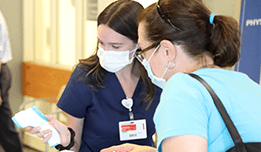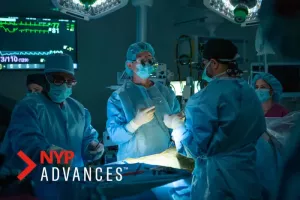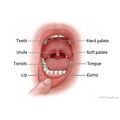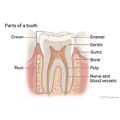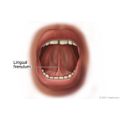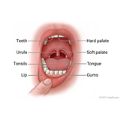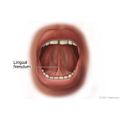Top of the pageCheck Your Symptoms
Mouth and Dental Injuries
Overview
Mouth, Opens dialog injuries are common, especially in children. They can involve the teeth, jaw, lips, tongue, inner cheeks, gums, roof of the mouth (hard or soft palates), neck, or tonsils, Opens dialog. Sometimes mouth injuries look worse than they are. Even a small cut or puncture inside the mouth may bleed a lot. That's because there are many blood vessels in the head and neck area. Home treatment of minor mouth injuries can help stop bleeding, reduce pain, help healing, and prevent infection.
Teeth, Opens dialog may be injured during a fall or a sport activity. A tooth may be knocked out (avulsed). You may be able to replace a permanent tooth in its socket (reimplant) if it has been knocked out or torn away from the socket. and dental care are needed right away when a permanent tooth has been knocked out.
An injury could crack, chip, or break a tooth. Or it could make a tooth change color. A tooth also may be loose or moved in position (dental luxation) or jammed into the gum (intruded).
Other dental injuries may be caused by grinding your teeth, especially at night. Your teeth may hurt, chip, or become loose. Biting surfaces may become flat and worn down. A broken or loose dental appliance or an orthodontic wire or bracket may poke or rub the inside of your mouth and make your mouth sore.
An injury to your mouth or lips may cause a large, loose flap of tissue or a gaping wound that may need stitches. A smaller wound on the lip may be stitched for cosmetic reasons. If an object, such as a piece of broken tooth or an orthodontic wire, gets stuck in a wound, you may need to have it removed by a doctor. You can also have problems from a piercing in the mouth.
The piece of skin between your lips and gums or under your tongue (frenulum, Opens dialog) may tear or rip. Usually this type of injury will heal without stitches. It's generally not a concern unless the tear was caused by physical or sexual abuse.
An injury to the roof of your mouth, the back of your throat, or a tonsil can injure deeper tissues in your head or neck. These injuries can happen when a child falls with a pointed object, such as a pencil or the stick from a frozen treat, in his or her mouth.
The medical assessment of symptoms is based on the body parts you have.
- If you are transgender or nonbinary, choose the sex that matches the body parts (such as ovaries, testes, prostate, breasts, penis, or vagina) you now have in the area where you are having symptoms.
- If your symptoms aren’t related to those organs, you can choose the gender you identify with.
- If you have some organs of both sexes, you may need to go through this triage tool twice (once as "male" and once as "female"). This will make sure that the tool asks the right questions for you.
Many things can affect how your body responds to a symptom and what kind of care you may need. These include:
- Your age. Babies and older adults tend to get sicker quicker.
- Your overall health. If you have a condition such as diabetes, HIV, cancer, or heart disease, you may need to pay closer attention to certain symptoms and seek care sooner.
- Medicines you take. Certain medicines, such as blood thinners (anticoagulants), medicines that suppress the immune system like steroids or chemotherapy, herbal remedies, or supplements can cause symptoms or make them worse.
- Recent health events, such as surgery or injury. These kinds of events can cause symptoms afterwards or make them more serious.
- Your health habits and lifestyle, such as eating and exercise habits, smoking, alcohol or drug use, sexual history, and travel.
Try Home Treatment
You have answered all the questions. Based on your answers, you may be able to take care of this problem at home.
- Try home treatment to relieve the symptoms.
- Call your doctor if symptoms get worse or you have any concerns (for example, if symptoms are not getting better as you would expect). You may need care sooner.
Symptoms of difficulty breathing can range from mild to severe. For example:
- You may feel a little out of breath but still be able to talk (mild difficulty breathing), or you may be so out of breath that you cannot talk at all (severe difficulty breathing).
- It may be getting hard to breathe with activity (mild difficulty breathing), or you may have to work very hard to breathe even when you're at rest (severe difficulty breathing).
Severe trouble breathing means:
- You cannot talk at all.
- You have to work very hard to breathe.
- You feel like you can't get enough air.
- You do not feel alert or cannot think clearly.
Moderate trouble breathing means:
- It's hard to talk in full sentences.
- It's hard to breathe with activity.
Mild trouble breathing means:
- You feel a little out of breath but can still talk.
- It's becoming hard to breathe with activity.
Severe trouble breathing means:
- The child cannot eat or talk because he or she is breathing so hard.
- The child's nostrils are flaring and the belly is moving in and out with every breath.
- The child seems to be tiring out.
- The child seems very sleepy or confused.
Moderate trouble breathing means:
- The child is breathing a lot faster than usual.
- The child has to take breaks from eating or talking to breathe.
- The nostrils flare or the belly moves in and out at times when the child breathes.
Mild trouble breathing means:
- The child is breathing a little faster than usual.
- The child seems a little out of breath but can still eat or talk.
Symptoms of infection may include:
- Increased pain, swelling, warmth, or redness in or around the area.
- Red streaks leading from the area.
- Pus draining from the area.
- A fever.
Certain health conditions and medicines weaken the immune system's ability to fight off infection and illness. Some examples in adults are:
- Diseases such as diabetes, cancer, heart disease, and HIV/AIDS.
- Long-term alcohol and drug problems.
- Steroid medicines, which may be used to treat a variety of conditions.
- Chemotherapy and radiation therapy for cancer.
- Other medicines used to treat autoimmune disease.
- Medicines taken after organ transplant.
- Not having a spleen.
Certain health conditions and medicines weaken the immune system's ability to fight off infection and illness. Some examples in children are:
- Diseases such as diabetes, cystic fibrosis, sickle cell disease, and congenital heart disease.
- Steroid medicines, which are used to treat a variety of conditions.
- Medicines taken after organ transplant.
- Chemotherapy and radiation therapy for cancer.
- Not having a spleen.
Pain in adults and older children
- Severe pain (8 to 10): The pain is so bad that you can't stand it for more than a few hours, can't sleep, and can't do anything else except focus on the pain.
- Moderate pain (5 to 7): The pain is bad enough to disrupt your normal activities and your sleep, but you can tolerate it for hours or days. Moderate can also mean pain that comes and goes even if it's severe when it's there.
- Mild pain (1 to 4): You notice the pain, but it is not bad enough to disrupt your sleep or activities.
Pain in children under 3 years
It can be hard to tell how much pain a baby or toddler is in.
- Severe pain (8 to 10): The pain is so bad that the baby cannot sleep, cannot get comfortable, and cries constantly no matter what you do. The baby may kick, make fists, or grimace.
- Moderate pain (5 to 7): The baby is very fussy, clings to you a lot, and may have trouble sleeping but responds when you try to comfort him or her.
- Mild pain (1 to 4): The baby is a little fussy and clings to you a little but responds when you try to comfort him or her.
Usually found in dirt and soil, tetanus bacteria typically enter the body through a wound. Wounds may include a bite, a cut, a puncture, a burn, a scrape, insect bites, or any injury that may cause broken skin. Tetanus can also happen with other infections, like dental infections. It can happen during a surgery or pregnancy and delivery.
A wound can be so small, you may not notice you have one. Or a skin blister could break and become an open wound. If there is any delay in finding or cleaning a wound, there is an increased risk for skin infection and a chance for tetanus to get in the wound. A tetanus infection can start 3 to 21 days after the bacteria enter the wound. Be especially careful about wounds on your fingers and toes.
Many people may not know when they got their last tetanus shot. So it's a good idea to call your doctor to see if you need one.
Make sure to stay up to date on your tetanus shots. A tetanus shot is recommended:
- For a dirty wound that has things like dirt, saliva, or feces in it, if you haven't had a tetanus shot in the past 5 years.
- For a clean wound, if you haven't had a tetanus shot in the past 10 years.
With severe bleeding, any of these may be true:
- Blood is pumping from the wound.
- The bleeding does not stop or slow down with pressure.
- Blood is quickly soaking through bandage after bandage.
With moderate bleeding, any of these may be true:
- The bleeding slows or stops with pressure but starts again if you remove the pressure.
- The blood may soak through a few bandages, but it is not fast or out of control.
With mild bleeding, any of these may be true:
- The bleeding stops on its own or with pressure.
- The bleeding stops or slows to an ooze or trickle after 15 minutes of pressure. It may ooze or trickle for up to 45 minutes.
If you can get to a dentist's office (or an emergency room) within an hour or two of the injury, the dentist may be able to reimplant the tooth in its socket.
To preserve the tooth until you get to the dentist:
- Pick up the tooth at its top, not at the root.
- Rinse the tooth with water. Do not rub or scrub it.
- Put the tooth back in the socket. Bite down gently on gauze or a clean cloth to keep the tooth in place, or hold the tooth in place with your finger. (This is not a good idea for anyone who might swallow the tooth.)
- Another option is to put the tooth in a small container of milk. Use tap water if you don't have milk.
Seek Care Now
Based on your answers, you may need care right away. The problem is likely to get worse without medical care.
- Call your doctor now to discuss the symptoms and arrange for care.
- If you cannot reach your doctor or you don't have one, seek care in the next hour.
- You do not need to call an ambulance unless:
- You cannot travel safely either by driving yourself or by having someone else drive you.
- You are in an area where heavy traffic or other problems may slow you down.
Call 911 Now
Based on your answers, you need emergency care.
Call 911 or other emergency services now.
Sometimes people don't want to call 911. They may think that their symptoms aren't serious or that they can just get someone else to drive them. Or they might be concerned about the cost. But based on your answers, the safest and quickest way for you to get the care you need is to call 911 for medical transport to the hospital.
Based on your answers, you may need care soon. The problem probably will not get better without medical care.
- Call your doctor or telehealth provider today to discuss the symptoms and arrange for care.
- If you cannot reach your doctor or telehealth provider or you don't have one, seek care today.
- If it is evening, watch the symptoms and seek care in the morning.
- If the symptoms get worse, seek care sooner.
What are your options for medical care?
Today your options for where to get your medical care are greater than ever before. You may not even have to leave your home to get the care you want and need. You can choose based on what your health problem is and what works best for you.
- Telehealth is a video call with a health care provider. It can be a convenient way to get medical advice or treatment. Some insurers provide access to telehealth that may be available 24 hours a day. Telehealth for less serious problems may cost less and be faster than in-person clinic visits.
- Urgent care and retail clinics are options if you don't have a doctor, you can't or don't want to wait to see your own doctor, or a telehealth visit can’t treat the problem.
- Virtual care from your primary provider or a telehealth service can be delivered through your smartphone, computer, or tablet.
Seek Care Now
Based on your answers, you may need care right away. The problem is likely to get worse without medical care.
- Call your dentist now to discuss the symptoms and arrange for care.
- If you cannot reach your dentist or you don't have one, seek care in the next hour.
Based on your answers, you may need care soon. The problem probably will not get better without medical care.
- Call your dentist or telehealth provider today to discuss the symptoms and arrange for care.
- If you cannot reach your dentist or telehealth provider or you don't have one, seek care today.
- If it is evening, watch the symptoms and seek care in the morning.
- If the symptoms get worse, seek care sooner.
Telehealth is a video call with a health care provider. It can be a convenient way to get medical advice or treatment. Some insurers provide access to telehealth that may be available 24 hours a day. Telehealth for less serious problems may cost less and be faster than in-person clinic visits.
Based on your answers, the problem may not improve without medical care.
- Make an appointment to see your doctor in the next 1 to 2 weeks, or contact your telehealth provider.
- If appropriate, try home treatment while you are waiting for the appointment.
- If symptoms get worse or you have any concerns, call your doctor or telehealth provider. You may need care sooner.
What are your options for medical care?
Today your options for where to get your medical care are greater than ever before. You may not even have to leave your home to get the care you want and need. You can choose based on what your health problem is and what works best for you.
- Telehealth is a video call with a health care provider. It can be a convenient way to get medical advice or treatment. Some insurers provide access to telehealth that may be available 24 hours a day. Telehealth for less serious problems may cost less and be faster than in-person clinic visits.
- Urgent care and retail clinics are options if you don't have a doctor, you can't or don't want to wait to see your own doctor, or a telehealth visit can’t treat the problem.
- Virtual care from your primary provider or a telehealth service can be delivered through your smartphone, computer, or tablet.
R 14.4.0.0
First aid steps for a possible mouth or dental injury
If you think that you might need to see a doctor, call to arrange for your care. Ask what steps to take in the meantime.
What steps to take will depend on the type of injury. Here are examples of some injuries and what you can do until you see your doctor or help arrives.
- A tooth that has been completely knocked out. A permanent tooth can sometimes be put back into its socket (reimplanted). So be sure to save the tooth, and place it in milk to keep it from drying out. Take it with you to the dentist right away. The best results occur if a dentist puts the tooth back in the socket within 30 minutes. Chances of successful reimplantation are unlikely after 2 hours.
- Bleeding in the mouth. Return any skin flap to its normal position. If needed, hold the flap in place with a clean cloth or gauze.
- A tongue or piece of tongue that has been cut off. Wrap the piece of tongue in a clean cloth or sterile gauze and put it in a bag of ice to keep it cool. Don't put the tongue directly on the ice. Don't immerse the tongue in ice water. Take the bag with you, and go to the emergency room right away.
- A broken tooth or dental appliance. Find any pieces of tooth or the broken dental appliance and take them with you when you go to see your dentist. Your dentist will want to check for missing pieces of tooth or dental appliance that may have been left in a wound, swallowed, or breathed into the lungs (aspirated).
Try these tips to treat a minor mouth or dental injury.
- Reduce pain.
- Apply a cold compress to the injured area. Or suck on a piece of ice.
- Rinse your wound with warm salt water. To make a saltwater solution for rinsing the mouth, mix 1/4 to 1/2 tsp (1.2 to 2.5 mL) of salt to 1 cup (250 mL) of warm water.
- If a jagged tooth or orthodontic wire or bracket is poking you, roll a piece of orthodontic wax and press it onto the part that is poking you. Use a pencil eraser to press a broken wire toward your teeth. These are only temporary measures to use until you can see your dentist or orthodontist to fix the problem.
- Try a topical medicine, such as Orabase or Anbesol, to reduce mouth pain. Ask your doctor before using mouth-numbing medicine for children of all ages. The U.S. Food and Drug Administration (FDA) warns that some of these can be dangerous.
- Eat soft foods that are easy to swallow.
- Try foods like soups, smoothies, or yogurt.
- Try meat and meat substitutes, such as tender meats or chicken, tuna, eggs, and smooth peanut butter.
- Eat fruits and vegetables, such as well-cooked or canned fruits and vegetables; well-ripened, easy-to-chew fruits; and baked, mashed, or well-cooked sweet potatoes.
- Avoid foods that might sting.
- These include salty or spicy foods, citrus fruits or juices, and tomatoes.
- Don't smoke or use other tobacco products.
- Don't drink alcohol.
When to call for help during self-care
Call a doctor if any of the following occur during self-care at home:
- New or worse signs of infection, such as redness, warmth, swelling, pus, or a fever.
- New or worse dehydration, Opens dialog.
- Symptoms occur more often or are more severe.
Learn more
Current as of: July 31, 2024
Author: Ignite Healthwise, LLC Staff
Clinical Review Board
All Ignite Healthwise, LLC education is reviewed by a team that includes physicians, nurses, advanced practitioners, registered dieticians, and other healthcare professionals.
Current as of: July 31, 2024
Author: Ignite Healthwise, LLC Staff
Clinical Review Board
All Ignite Healthwise, LLC education is reviewed by a team that includes physicians, nurses, advanced practitioners, registered dieticians, and other healthcare professionals.


